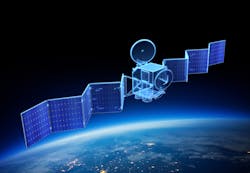Space industry eyes radiation-tolerant high-voltage transistors to enhance spacecraft power efficiency
ARLINGTON, Va. – U.S. military researchers are asking industry to develop radiation-tolerant high-voltage transistors with high performance and small size to enable compact, high-conversion-ratio point-of-load power converters for space applications.
Officials of the U.S. Defense Advanced Research Projects Agency (DARPA) in Arlington, Va., have issued a broad agency announcement (HR001122S0059) for the Space Power Conversion Electronics (SPCE) project.
SPCE seems to develop high-performance integrated radiation-tolerant high-voltage transistors that perform better than today's advanced wide bandgap semiconductor (WBGS) high-voltage devices for non-radiation environments.
Researchers seek to demonstrate a 48 V-to-1 V radiation-tolerant point-of-load converter with better than 85 percent power at 50 amps of output current, with power density greater than 500 Watts per cubic inch.
Related: Radiation tolerance meets commercial space
To do this, researchers have laid out two key technical challenges: achieving a high-performance high-voltage transistor that is radiation-tolerant; and achieving a low-loss, high-voltage integrated circuit that is radiation tolerant.
Today's most advanced space point-of-load systems use discrete radiation-hardened silicon lightly doped-drain MOSFET (LDMOS) transistors, which limit the overall point-of-load efficiency to less than 60 percent.
To avoid single-event burnout, these LDMOS transistors operate at a maximum voltage substantially lower than the device breakdown voltage, which leads to degradation in performance.
For a space-qualified 100-volt LDMOS, the figure of merit is more than 3 times worse than for an LDMOS transistor for non-radiation environments. This results in a significant increase in the switch power loss, and a reduced point-of-load conversion efficiency.
Related: Radiation hardening meets smart satellites
Experts recently have looked into wide bandgap semiconductors such as gallium nitride (GaN) and silicon carbide (SiC) for space applications. With their large breakdown voltages and high carrier mobilities, wide-bandgap semiconductor transistors promise a 10-to-100-fold better figure of merit than LDMOS.
However, wide-bandgap semiconductor transistors also are prone to single-event burnout in radiation environments and require as much as four times the voltage derating, which has limited their performance for space power converters.
The most common terrestrial monolithic integrated power electronic technology, Bipolar-CMOS-DMOS (BCD) is not suitable for demanding space missions because of its poor radiation reliability and performance of old-node CMOS, and degraded DMOS capabilities after derating.
In addition, advanced space-qualified high voltage transistors have large junction sizes and sizes as large as tens of square nanometers due to voltage derating, which can prevent monolithic integration with advanced microelectronics.
Related: The evolving world of radiation-hardened electronics for space
Because of this, today's advanced space point-of-load systems are based on discrete implementations of the LDMOS devices and passive components, which can result in power density of less than 50 Watts per cubic inch, with long and lossy electrical connections.
The SPCE seeks to overcome these technological drawbacks with two technical areas: radiation-tolerant high-performance high-voltage transistor and high-efficiency point-of-load DC-DC converter; and fundamental device exploration.
Companies interested should upload full proposals no later than 6 Dec. 2022 to the DARPA BAA website at https://baa.darpa.mil. Email questions or concerns to DARPA at [email protected].
More information is online at https://sam.gov/opp/92fe936d10b043adafed6a1b843450d1/view.

John Keller | Editor-in-Chief
John Keller is the Editor-in-Chief, Military & Aerospace Electronics Magazine--provides extensive coverage and analysis of enabling electronics and optoelectronic technologies in military, space and commercial aviation applications. John has been a member of the Military & Aerospace Electronics staff since 1989 and chief editor since 1995.

